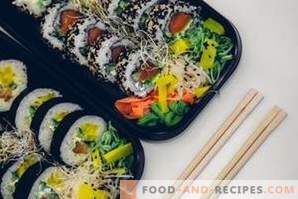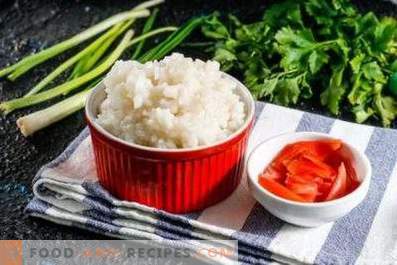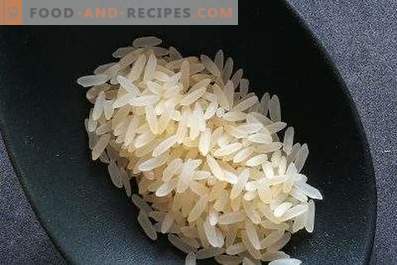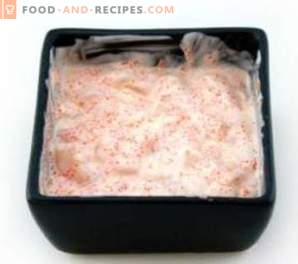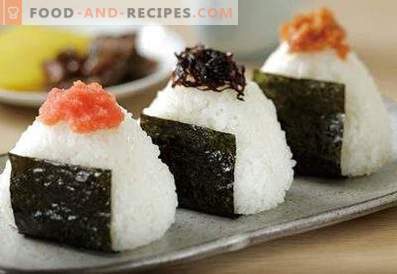
Asian cuisine is considered unusual compared to European. Due to its geographical location, it mainly consists of a combination of sea food and rice grown in the country. If earlier, few people knew about it, but now Asian cuisine has become quite popular. Especially Europeans liked sushi and rolls. In fact, sushi and rolls are the same dish (rolls are a type of sushi), but only rolls have a rounded shape in the form of a roll, are prepared using a bamboo mat, are consumed hot and can have stuffing not only from seafood.
Rice varieties for rolls
Rolls, like any other dish, can be prepared at home, but only for this you first need to choose the right ingredients. Rice is the basis of sushi, so it needs to pay special attention.
To make the rolls tasty and have the right texture, you need:
- Choose a rice variety whose grains are perfectly glued when cooked. If there is not enough starch in the croup, the rolls will not be able to give the desired shape, besides, they will be showered when dipped in soy sauce.
- To give preference to such rice, which perfectly absorbs water, boils well, but as a result of cooking does not turn into a homogeneous mush.
- Pay attention to the shape of the rice. The rice is smaller and rounder, the tastier sushi is obtained.
The following varieties of rice cereal are suitable for the above criteria:
- Fushigon is rice specially bred in Japan, which is the basis of Japanese cuisine. Fushigon has short round-shaped grains and belongs to premium rice. Samurai rice, as it is called, is suitable for many Japanese dishes, including rolls. This croup is valued for excellent shape retention after cooking and high stickiness. In addition, Fushigon has a rich chemical composition, which is stored in it after preparation.
- Urutimai is another rice variety with small grains used to make sushi. It has a high percentage of starch, which makes the croup sticky. Urutimai has a rich sweetish taste.
- Hakumay is used to make rolls at least two of the above rice varieties. This is a rice with a short round shape, which is perfectly amenable to molding, since it contains a lot of starchy substance. During cooking, the rice grains grow about 2, 5 times, while maintaining their structure.
- Nishiki is the only variety of rice grown in Japan because of its taste and consumer qualities. It is perfectly suited for making rolls. Its size is perfect, it has a high stickiness, plus it does not boil soft to a uniform consistency and has a mild flavor without a viscous taste.
- Okomesan, like all previous rice varieties, is excellent for preparing such dishes as sushi. Due to the large amount of starch, rice when cooking becomes creamy consistency. In other words, it perfectly “crumples” and does not fall apart, which is very important in the manufacture of rolls.
Please note that wild and red rice is absolutely not suitable for rolls. Also, delicious sushi from long grain rice varieties will not work.
When choosing rice for rolls, you should consider the method of processing cereals. Do not buy steamed rice. It has a low content of starchy substances, because it has a weak stickiness.
Secrets of delicious rolls
- One of the important rules for making sushi is to use only the freshest ingredients. Carefully review the shelf life of each ingredient.
- Rice should be thoroughly washed before cooking. This should be done until the water becomes almost transparent.
- The filling should be introduced into hot boiled rice. It is advisable to perform this manipulation in a wooden tank with a wooden spatula in order to remove excess moisture from the cereal. Add the sauce to the rice evenly. It is most correct to pour it on the spatula, and then it will drain from it into rice.
- Stir rice with dressing only with a spatula. Carefully drive her clockwise, not forgetting to break the lumps formed. After soaking the sauce, give the rice a 5-minute rest, then turn it over to the other side and repeat the same procedure again. Don't forget to let the rice stand for another 5 minutes.
- You need to cook the rolls when the rice has cooled. And it should be done with cold hands. So that the ingredients do not stick to the hands, they can be moistened in a solution consisting of 2-3 tablespoons of rice vinegar and a glass of water.
- The ingredients of the rolls should be cut into cubes with a sharp, long knife.
When cooking rolls at home, remember that this is the dish that you need to eat immediately after cooking. After a few hours, the rolls will start to deteriorate, so never cook them in reserve.

